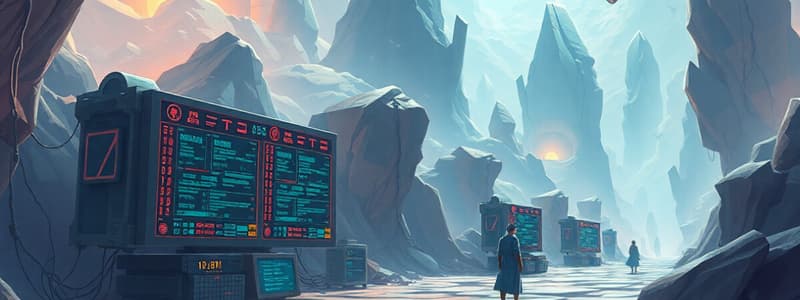Podcast
Questions and Answers
An operating system is responsible for coordinating the operation of all hardware and software components of a computer system.
An operating system is responsible for coordinating the operation of all hardware and software components of a computer system.
True (A)
Memory Management in an operating system does not involve controlling virtual memory.
Memory Management in an operating system does not involve controlling virtual memory.
False (B)
The User Interface allows users to access programs and change system settings.
The User Interface allows users to access programs and change system settings.
True (A)
Mobile operating systems include only Windows Phone and Symbian.
Mobile operating systems include only Windows Phone and Symbian.
The Application Program Interface (API) serves as an interface between applications and the operating system.
The Application Program Interface (API) serves as an interface between applications and the operating system.
Software consists solely of hardware components.
Software consists solely of hardware components.
Applications software enables a computer user to perform specific tasks.
Applications software enables a computer user to perform specific tasks.
System software includes utility programs that perform maintenance tasks.
System software includes utility programs that perform maintenance tasks.
Programming languages are not used to implement algorithms.
Programming languages are not used to implement algorithms.
A virtual machine only refers to physical hardware components.
A virtual machine only refers to physical hardware components.
Flashcards are hidden until you start studying
Study Notes
Operating Systems
- An operating system is a software program that manages computer hardware and software resources.
- It acts as an intermediary between the user and the computer hardware.
- It coordinates the operation of all hardware and software components.
- The operating system is essential for the proper function of a computer system.
- Examples include Windows, macOS, Linux, Android, and iOS.
Operating System Functions
- Job Scheduling: Organizes and manages the execution of tasks on the CPU.
- Resource Management: Manages and allocates resources such as memory, input/output (I/O), and data transfer.
Operating System Components
- Memory Management:
- Allocates memory space to different programs.
- Ensures programs stay within their allocated memory boundaries.
- Controls virtual memory, which allows programs to use more memory than physically available.
- I/O System:
- Manages communication between the system and peripherals (e.g., printers, mice, keyboards).
- Coordinates I/O systems such as interrupts and direct memory access.
- File System:
- Organizes and accesses files on the computer.
- Maintains user file quotas on multi-user systems.
- Controls access to individual files and records.
- Application Program Interface (API):
- Provides services for applications to interact with the operating system.
- Allows applications to access system resources.
- User Interface:
- Enables users to interact with the operating system.
- Provides access to programs, settings, and system information.
- Aims to provide a consistent interface for the user.
Software Definition
- Software consists of programs and data that a computer uses.
- Programs are sets of instructions that the processor follows.
- Data refers to any information a program requires, including character data, numerical data, image data, and audio data.
- Both programs and data are saved in computer memory.
Types of Software
- Software is categorized into three main types: systems software, applications software, and programming languages.
System Software
- System software manages computer resources and simplifies computer usage.
- The operating system is a type of system software responsible for managing computer resources and overseeing user program execution.
- Utility programs assist users with maintenance tasks, such as managing the computer, devices, or programs.
Applications Software
- Applications software empowers users to perform specific tasks.
Programming Languages
- Programming languages are a form of computer language used in computer programming to implement algorithms.
- Most programming languages provide instructions for computers.
Virtual Machine
- A virtual machine is the set of services and resources presented to the user by the software.
- Programmers should not be required to understand registers, addition circuits, or memory addresses but instead interact with a virtual machine that interprets symbols like "+" and "=".
Studying That Suits You
Use AI to generate personalized quizzes and flashcards to suit your learning preferences.





